A Simple Change for the Buy-In, Accountability and Agility You Want
Prefer to watch the video? Just click here. 4 minutes, with captions.
Your people want more communication. I know this because your latest staff survey had this as the second-biggest issue behind cross-functional work.
You want more buy-in and commitment. You also want more accountability or ownership taken, and you want your team, your division, your organisation to be more adaptable, responsible, or dare I say it….that ‘a’ word.
The good news is there’s a simple step you can put in place that lays the foundation for this (not the panacea…but the foundation)
Be networked they cry!
If you’ve been alive and in organisations this century, you’re tired of being told that you need to go from this:
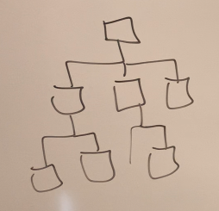
To this:
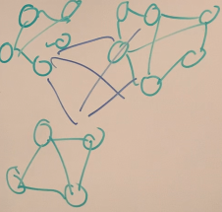
The networked organisation, ready to adapt to whatever the environment needs. And it’s not a bad idea – to choose an example from nature, these guys below are structured just enough to be able to go with whatever their environment needs, yet can hang together.
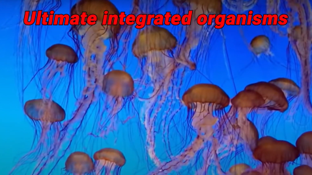
The standard meeting
Let’s now look at the way we run meetings. Like the jellyfish above who don’t notice the water, we do meetings this way so automatically, we don’t even notice.
Senior manager meets with less senior directs.
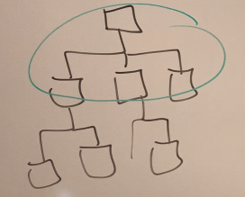
Less senior manager directs meet with less senior directs.
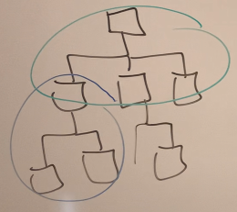
And so on.
The Change
Here’s the simple change: Invite everyone!
That’s it! Invite everyone to your regular meetings. Do this, and you will be meeting like a networked organisation, where everyone gets the same knowledge at the same time, so they can contribute their own piece of the puzzle while being connected to the larger whole.
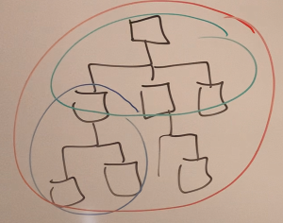
Why Not?
Let’s go through the reasons why this doesn’t happen. Remember, we’re that used to doing this, it’s the standard ‘fish don’t notice the water’ thing (or, as a friend of mine pointed out a couple of weeks ago – humans don’t notice the air!)
Inefficiency – trade-off for integration
It’s inefficient. This is true. More people means more complexity, even things like waiting for everyone to connect in. However, this inefficiency is only in the short-term. As I went through in my article on the Adizes Managerial Roles, efficiency in the long-term is known as integration as we can move as one toward new futures. And integration requires all the aspects of the system feeling the environment together…which occurs by everyone being in the meeting.
Sensitive info – trade-off for systemic knowledge
The human need to first not mess things up sees us naturally wanting to control information. So we forget that the purpose of information is to provide the context so people can do their part. When we withhold information, we are reducing the level of systemic knowledge – information shared by the whole system.
This is grey area stuff – there is always going to be information that is not for the full system (nuclear launch codes perhaps, or that you really did eat that whole bag of corn chips last night as you went down a YouTube rabbit hole), but it is crucial that a deliberate trade-off is made each time against the need for systemic knowledge. And that this be done in full awareness that the natural bias is toward withholding.
Annoying people – earn management salary
And perhaps the most dominating issue of all…. annoying people! It’s maths – if the percentage of annoying people is constant, inviting more people lifts the number of them you are now involved with. The solution here is simple (maybe not easy, but simple), which is to earn our management dollars. After the meeting, address the behaviour, the usual stuff around pointing out the cause, the effect, why it needs to change, asking what they will do to make the change, and offering support for the change.

How Many?

General Stanley McChrystal was in charge of the US Joint Task Force fighting Al-Qaeda in Iraq. And they were losing in a classic David v Goliath situation. One of the crucial practices that was adopted was a change to the daily Operations and Intelligence meeting, the purpose of which is to share knowledge to improve the success of each operation and the battle overall.
The change? McChrystal decided to invite everyone. As in, everyone.
How many?
7,000!
7,000 people tuned in to this meeting everyday, 4pm Iraq, 9am Washington.
McChrystal addressed the sensitive information issue directly – by the clear evidence that the meetings were resulting in greater success for his mission. And by acknowledging that this was, indeed, a trade-off. One well worthwhile.
And the original idea came from McChrystal’s looking into how NASA achieved cross-organisational communication and working together in their moon landings way back when. (You can read about this in McChrystal’s book Team of Teams – worth your small amount of dollars and time).
Your Next Action
You don’t have to send out the Zoom link for your exec meeting to your 5,000-person organisation this afternoon. That’s a big ask.
What you can do, however, is invite the next layer into the next meeting. Stick some chairs around the walls. And don’t make it mandatory. In fact, the number that show up at the start is a good measure of the level of trust, and the number that keep coming is a measure of the quality of your information.
Then look for the chance to extend it further.
Give it a go. Think about what you’ve got to lose. The answer is not much. Think about what you’ve got to gain – the ability for your organisation to be more empowered and to move as one due to the level of systemic knowledge you can create.
And that’s cool.
That’s all for now. Thank you for reading. If you want to hear me go through this stuff the video is here. And if you’d like 30 minutes of my time to talk through how this might work in your particular situation, just Reply to this email.
